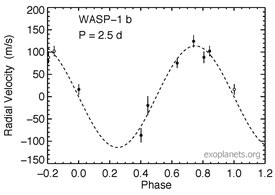WASP-1b
 Size comparison of WASP-1b with Jupiter | |
| Discovery | |
|---|---|
| Discovered by | Cameron et al. (SuperWASP and SOPHIE) and |
| Discovery site | SAAO |
| Discovery date | September 25, 2006 |
| Transit | |
| Orbital characteristics | |
| 0.0382 (± 0.0013) AU | |
| Eccentricity | 0 |
| 2.5199464 (± 8e-07) d | |
| Inclination | 88.65 (± 0.55) |
| Star | WASP-1 |
| Physical characteristics | |
| 1.484 +0.06 −0.09 RJ | |
| Mass | 0.86 ± 0.07 MJ |
Mean density | 0.476 g/cm3[citation needed] |
| 12.5 m/s2 (41 ft/s2) 1.27 g | |
| Temperature | 1,800 K |
WASP-1b is an extrasolar planet orbiting the star WASP-1 located 1,300 light-years away in the constellation Andromeda.
Orbit and mass

The planet's mass and radius indicate that it is a gas giant with a similar bulk composition to Jupiter. Unlike Jupiter, but similar to many other planets detected around other stars, WASP-1b is located very close to its star, and belongs to the class of planets known as hot Jupiters.
WASP-1 b was discovered via the transit method by SuperWASP, for which the star and planet are named. Follow-up radial velocity measurements confirmed the presence of an unseen companion, and allowed for the mass of WASP-1 b to be determined.[1]
In 2018, it was discovered via observations of the Rossiter-McLaughlin effect that the orbit of WASP-1b is strongly misaligned with rotational axis of the star by 79.0+4.3
−4.5 degrees, making it a nearly "polar" orbit.[2]
See also
References
- ^ Cameron, A. Collier; et al. (2007). "WASP-1b and WASP-2b: two new transiting exoplanets detected with SuperWASP and SOPHIE". Monthly Notices of the Royal Astronomical Society. 375 (3): 951–957. arXiv:astro-ph/0609688. Bibcode:2007MNRAS.375..951C. doi:10.1111/j.1365-2966.2006.11350.x. S2CID 735515.
- ^ Simpson, E. K.; Pollacco, D.; Cameron, A. Collier; Hébrard, G.; Anderson, D. R.; Barros, S. C. C.; Boisse, I.; Bouchy, F.; Faedi, F.; Gillon, M.; Hebb, L.; Keenan, F. P.; Miller, G. R. M.; Moutou, C.; Queloz, D.; Skillen, I.; Sorensen, P.; Stempels, H. C.; Triaud, A.; Watson, C. A.; Wilson, P. A. (2011). "The spin-orbit angles of the transiting exoplanets WASP-1b, WASP-24b, WASP-38b and HAT-P-8b from Rossiter-Mc Laughlin observations★". Monthly Notices of the Royal Astronomical Society. 414 (4): 3023–3035. arXiv:1011.5664. Bibcode:2011MNRAS.414.3023S. doi:10.1111/j.1365-2966.2011.18603.x. S2CID 46522188.
Further reading
- Charbonneau, David; Winn, Joshua N.; Everett, Mark E.; Latham, David W.; Holman, Matthew J.; Esquerdo, Gilbert A.; o’Donovan, Francis T. (2007). "Precise Radius Estimates for the Exoplanets WASP-1b and WASP-2b". The Astrophysical Journal. 658 (2): 1322–1327. arXiv:astro-ph/0610589. Bibcode:2007ApJ...658.1322C. doi:10.1086/512008. S2CID 14099767.
- Shporer, A.; Tamuz, O.; Zucker, S.; Mazeh, T. (2007). "Photometric follow-up of the transiting planet around WASP-1". Monthly Notices of the Royal Astronomical Society. 376 (3): 1296–1300. arXiv:astro-ph/0610556. Bibcode:2007MNRAS.376.1296S. doi:10.1111/j.1365-2966.2007.11537.x. S2CID 12694181.
External links
![]() Media related to WASP-1b at Wikimedia Commons
Media related to WASP-1b at Wikimedia Commons
- "Planet WASP-1 b". Extrasolar Planets Encyclopaedia. Retrieved 2018-11-07.
- BBC News article
- WASP Planets
